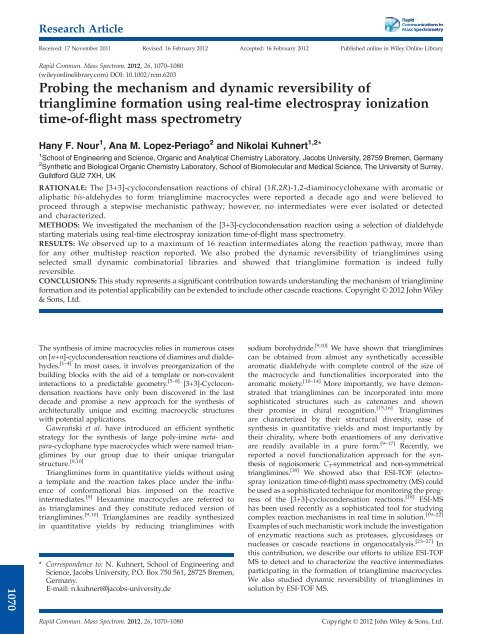The Development of Novel Antibiotics Using ... - Jacobs University
The Development of Novel Antibiotics Using ... - Jacobs University
The Development of Novel Antibiotics Using ... - Jacobs University
You also want an ePaper? Increase the reach of your titles
YUMPU automatically turns print PDFs into web optimized ePapers that Google loves.
Research Article<br />
Received: 17 November 2011 Revised: 16 February 2012 Accepted: 16 February 2012 Published online in Wiley Online Library<br />
Rapid Commun. Mass Spectrom. 2012, 26, 1070–1080<br />
(wileyonlinelibrary.com) DOI: 10.1002/rcm.6203<br />
Probing the mechanism and dynamic reversibility <strong>of</strong><br />
trianglimine formation using real-time electrospray ionization<br />
time-<strong>of</strong>-flight mass spectrometry<br />
Hany F. Nour 1 , Ana M. Lopez-Periago 2 and Nikolai Kuhnert 1,2 *<br />
1 School <strong>of</strong> Engineering and Science, Organic and Analytical Chemistry Laboratory, <strong>Jacobs</strong> <strong>University</strong>, 28759 Bremen, Germany<br />
2 Synthetic and Biological Organic Chemistry Laboratory, School <strong>of</strong> Biomolecular and Medical Science, <strong>The</strong> <strong>University</strong> <strong>of</strong> Surrey,<br />
Guildford GU2 7XH, UK<br />
RATIONALE: <strong>The</strong> [3+3]-cyclocondensation reactions <strong>of</strong> chiral (1R,2R)-1,2-diaminocyclohexane with aromatic or<br />
aliphatic bis-aldehydes to form trianglimine macrocycles were reported a decade ago and were believed to<br />
proceed through a stepwise mechanistic pathway; however, no intermediates were ever isolated or detected<br />
and characterized.<br />
METHODS: We investigated the mechanism <strong>of</strong> the [3+3]-cyclocondensation reaction using a selection <strong>of</strong> dialdehyde<br />
starting materials using real-time electrospray ionization time-<strong>of</strong>-flight mass spectrometry.<br />
RESULTS: We observed up to a maximum <strong>of</strong> 16 reaction intermediates along the reaction pathway, more than<br />
for any other multistep reaction reported. We also probed the dynamic reversibility <strong>of</strong> trianglimines using<br />
selected small dynamic combinatorial libraries and showed that trianglimine formation is indeed fully<br />
reversible.<br />
CONCLUSIONS: This study represents a significant contribution towards understanding the mechanism <strong>of</strong> trianglimine<br />
formation and its potential applicability can be extended to include other cascade reactions. Copyright © 2012 John Wiley<br />
& Sons, Ltd.<br />
1070<br />
<strong>The</strong> synthesis <strong>of</strong> imine macrocycles relies in numerous cases<br />
on [n+n]-cyclocondensation reactions <strong>of</strong> diamines and dialdehydes.<br />
[1–4] In most cases, it involves preorganization <strong>of</strong> the<br />
building blocks with the aid <strong>of</strong> a template or non-covalent<br />
interactions to a predictable geometry. [5–8] [3+3]-Cyclocondensation<br />
reactions have only been discovered in the last<br />
decade and promise a new approach for the synthesis <strong>of</strong><br />
architecturally unique and exciting macrocyclic structures<br />
with potential applications.<br />
Gawroński et al. have introduced an efficient synthetic<br />
strategy for the synthesis <strong>of</strong> large poly-imine meta- and<br />
para-cyclophane type macrocycles which were named trianglimines<br />
by our group due to their unique triangular<br />
structure. [9,10]<br />
Trianglimines form in quantitative yields without using<br />
a template and the reaction takes place under the influence<br />
<strong>of</strong> conformational bias imposed on the reactive<br />
intermediates. [9] Hexaamine macrocycles are referred to<br />
as trianglamines and they constitute reduced version <strong>of</strong><br />
trianglimines. [9,10] Trianglamines are readily synthesized<br />
in quantitative yields by reducing trianglimines with<br />
* Correspondence to: N. Kuhnert, School <strong>of</strong> Engineering and<br />
Science, <strong>Jacobs</strong> <strong>University</strong>, P.O. Box 750 561, 28725 Bremen,<br />
Germany.<br />
E-mail: n.kuhnert@jacobs-university.de<br />
Rapid Commun. Mass Spectrom. 2012, 26, 1070–1080<br />
sodium borohydride. [9,10] We have shown that trianglimines<br />
can be obtained from almost any synthetically accessible<br />
aromatic dialdehyde with complete control <strong>of</strong> the size <strong>of</strong><br />
the macrocycle and functionalities incorporated into the<br />
aromatic moiety. [10–14] More importantly, we have demonstrated<br />
that trianglimines can be incorporated into more<br />
sophisticated structures such as catenanes and shown<br />
their promise in chiral recognition. [15,16] Trianglimines<br />
are characterized by their structural diversity, ease <strong>of</strong><br />
synthesis in quantitative yields and most importantly by<br />
their chirality, where both enantiomers <strong>of</strong> any derivative<br />
are readily available in a pure form. [9–17] Recently, we<br />
reported a novel functionalization approach for the synthesis<br />
<strong>of</strong> regioisomeric C 3 -symmetrical and non-symmetrical<br />
trianglimines. [18] We showed also that ESI-TOF (electrospray<br />
ionization time-<strong>of</strong>-flight) mass spectrometry (MS) could<br />
be used as a sophisticated technique for monitoring the progress<br />
<strong>of</strong> the [3+3]-cyclocondensation reactions. [18] ESI-MS<br />
has been used recently as a sophisticated tool for studying<br />
complex reaction mechanisms in real time in solution. [19–22]<br />
Examples <strong>of</strong> such mechanistic work include the investigation<br />
<strong>of</strong> enzymatic reactions such as proteases, glycosidases or<br />
nucleases or cascade reactions in organocatalysis. [23–27] In<br />
this contribution, we describe our efforts to utilize ESI-TOF<br />
MS to detect and to characterize the reactive intermediates<br />
participating in the formation <strong>of</strong> trianglimine macrocycles.<br />
We also studied dynamic reversibility <strong>of</strong> trianglimines in<br />
solution by ESI-TOF MS.<br />
Copyright © 2012 John Wiley & Sons, Ltd.

















